In this article:
Conjunctivitis, or pink eye, refers to the inflammation of the conjunctiva, which is a thin, transparent, mucous membrane lining the inside of the eyelid and the outer surface of the eyeball.
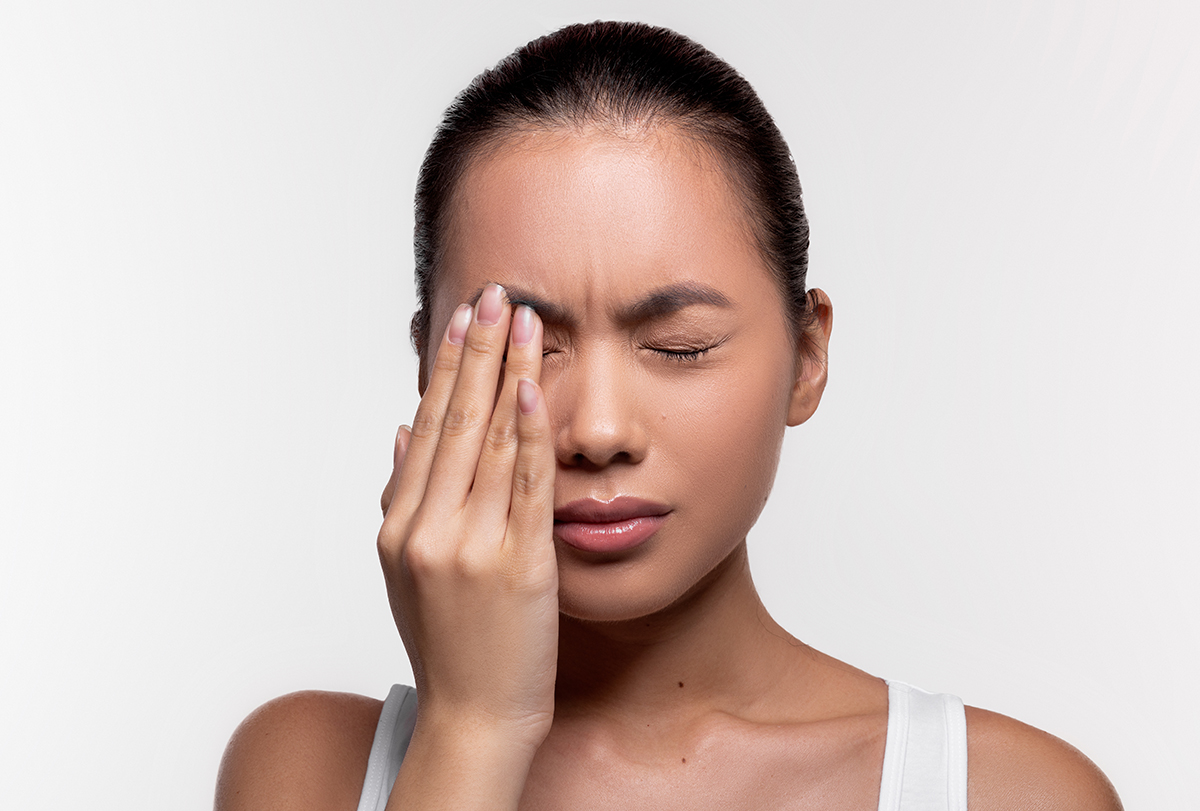
The dilation of superficial ocular vessels can result from infection, allergy, inflammation (noninfectious), and elevated intraocular pressure. (1)
Three different causes can give rise to this relatively common but discomforting condition, namely, viral or bacterial infection, allergic reaction, and injury or irritation to the conjunctiva.
This article will solely focus on allergic conjunctivitis and how to treat it at home.
Two types of allergens can trigger allergic conjunctivitis:
- Outdoor allergens such as pollen, ragweed, dust, grass, and mold (2)
- Indoor allergens such as animal dander, dust, and indoor mold spores
Cause and Symptoms of Allergic Conjunctivitis
The underlying cause of conjunctivitis could be infectious or noninfectious in nature. It is most commonly the result of a viral infection, with bacterial conjunctivitis coming in second.
Among noninfectious etiologies, allergic conjunctivitis and toxin-induced conjunctivitis top the list. (1)
Allergic conjunctivitis occurs when allergens or irritants enter the eye and come in contact with the conjunctiva and induce an immune response from the body.
Antibodies are present in the tear film and are attached to certain cells in the eye; they react with these allergens to trigger the release of an inflammatory compound called histamine. The body identifies these allergens as a threat and produces histamine to counter them. (1)
Histamine, in turn, causes inflammation in the conjunctiva as well as other parts of the body, leading to the following symptoms:
- Nasal congestion
- Swollen eyelids
- Thin, watery, or stringy mucus discharges from the eyes
- Redness, itching, or burning in the eyes and the surrounding area
- Blurred vision (due to swelling in the conjunctiva)
- Sensitivity to bright light
Specific clinical findings have shown that allergic conjunctivitis typically causes fluid retention and excessive blood flow in the conjunctival tissue. This can make your eyelid turn red and swollen while also triggering discharge from the eyes.
Moreover, the inflammation in and around the eyelid causes chronic itching, which can lead to chronic eyelid rubbing, periocular hyperpigmentation, and dermatitis.
Seasonal and perennial conjunctivitis leads to the formation of fine bumps on the upper tarsal conjunctiva, which make it feel and appear velvety. In severe cases, this condition can result in corneal scarring, which can compromise your visual acuity.
Vernal keratoconjunctivitis is a severe form of allergic conjunctivitis that mostly involves the palpebral conjunctiva of the upper eyelid and sometimes the bulbar conjunctiva. What makes this condition different from other types of allergic conjunctivitis is that it often affects the cornea as well.
It is characterized by a thick, stringy, and mucus-like discharge from the eyes. In some cases, it may also trigger the development of a painful, small, open sore on the eyelid. (3)
Home Remedies for Allergic Conjunctivitis
When it comes to combating inflammation of the conjunctiva, the following are the most commonly used home remedies.
1. Apply a cold compress
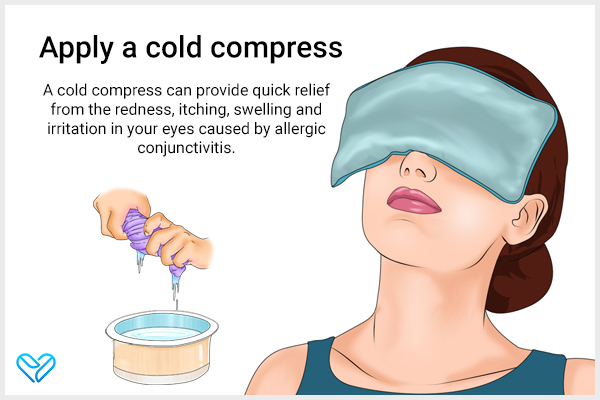
A cold compress can provide quick relief from the redness, itching, swelling, and irritation in your eyes caused by allergic conjunctivitis.
The application of cold temperature shrinks the underlying blood vessels and thus restricts blood flow in the area, which may help bring down inflammation. Plus, it temporarily numbs the area, making you feel less pain.
However, this soothing effect is quite short lived, so you need to reapply the cold compress multiple times throughout the day for lasting relief. (4)
How to use:
- Soak a clean towel or washcloth in cold water. Use a separate cloth for each eye if both of them are affected.
- Squeeze out the excess liquid.
- Close your eye, and keep the moist cloth over it for as long as it remains cold.
- Reapply three or four times a day or every hour, but make sure to use a fresh cloth every time.
2. Use a warm washcloth
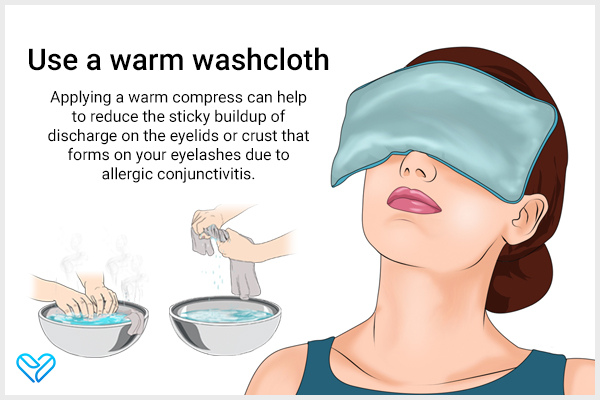
Allergic conjunctivitis often causes a stringy mucus discharge from the eyes that can make your eyelashes stick together, blur your vision, and form dry, hardened deposits inside the eye or under the eyelid.
Applying a warm compress to the affected eye can help loosen this clumpy discharge to make it easier to remove or clean. The gentle heat also stimulates blood circulation in the area, which helps deliver more infection-fighting immune cells and healing nutrients to the eye.
It can also help to reduce the sticky buildup of discharge on the eyelids or crust that forms on your eyelashes. (5)(6)
How to use:
- Soak a clean, soft towel or washcloth in warm water. Use a separate cloth for each eye if both of them are affected.
- Wring out the excess liquid.
- Place the damp towel/cloth on your closed eyelid.
- Leave it on for as long as it stays warm.
- Take a clean, soft towel and wipe the discharge or wash your eye with normal water.
- Do this multiple times throughout the day, but use a clean cloth for every application.
3. Try eye drops
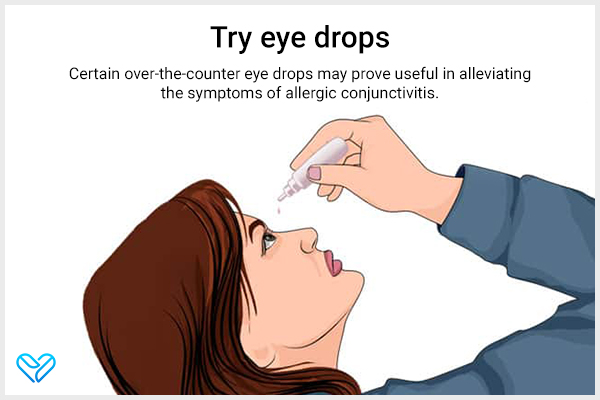
Certain over-the-counter eye drops may prove useful in alleviating the symptoms of allergic conjunctivitis. These include teardrops or artificial tears, (4) which can help flush out the allergens and inflammatory cells from the eye.
There are also some eye drops that are specifically formulated to treat allergy symptoms such as ketotifen and olopatadine. They contain antihistamines that reduce the inflammation in the eye by neutralizing histamine.
To determine the correct dosage, read the label carefully and consult your doctor.
4. Use cucumber slices
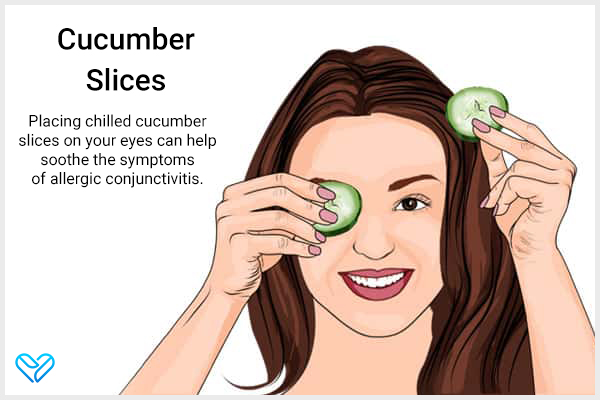
Placing chilled cucumber slices on your eyes can help soothe the symptoms of allergic conjunctivitis. This water-rich plant is packed with antioxidants that can help reduce inflammation in and around the eyes.
Refrigerating the slices before application will give you the added benefits of a cold compress.
5. Use rosewater
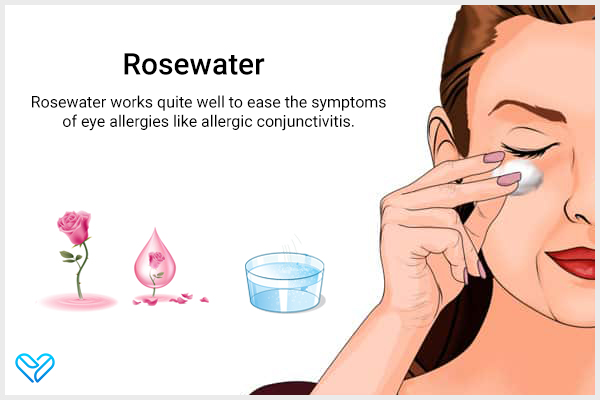
Rosewater works quite well in easing the symptoms of eye allergies such as allergic conjunctivitis. (7) It can be used as an eye rinse to remove the allergen and mucus discharge. Plus, its cooling nature can help calm your irritated eyes.
How to use:
- Gently wash your eyes with pure rosewater two or three times daily.
- Dip 2 cotton balls in rosewater, and apply them to your closed eyelids for 15–20 minutes, two to three times daily.
6. Try chamomile tea
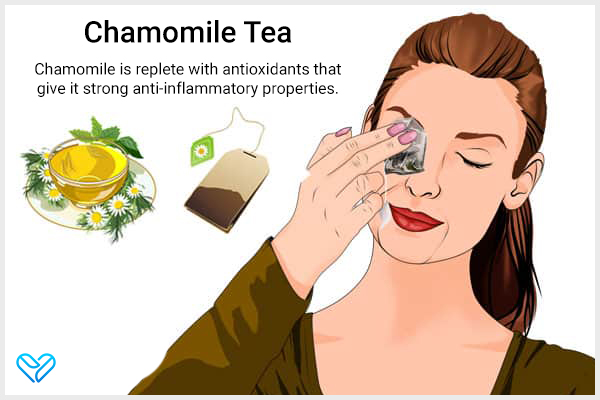
Chamomile is replete with antioxidants that give it strong anti-inflammatory properties. For this reason, it may help curb the swelling, redness, itching, and irritation (8) in the eyes caused by allergic conjunctivitis.
How to use:
- Steep 2 chamomile tea bags in 2 cups of hot water for 5 minutes. Remove the tea bags and set them aside in the refrigerator. Put the chilled tea bags over your closed eyes for about 10 minutes. Do these three or four times a day for fast recovery.
- Use the cool chamomile tea as eyewash, two or three times a day.
7. Use calendula
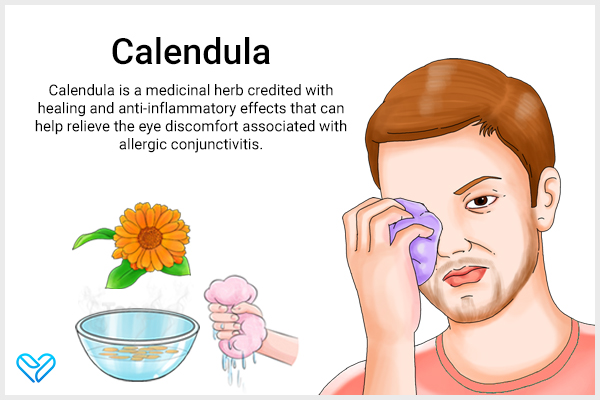
Calendula is a medicinal herb credited with healing and anti-inflammatory effects that can help relieve the eye discomfort associated with allergic conjunctivitis. (9) Plus, it works as a sanitizing agent that can help clear out the allergen and discharge from your eyes.
How to use:
Method 1
- Fill a cup with hot water. Put 2 teaspoons of dried calendula flowers in it.
- Once it cools down, strain the mixture using gauze or a coffee filter.
- Use this calendula-infused water to wash your eyes multiple times a day.
Method 2
- Fill a cup with hot water. Put 2 teaspoons of dried calendula flowers in it.
- Once it becomes comfortably warm, dip a clean cloth in this herbal mixture.
- Wring out the excess liquid, and then place the damp cloth on your closed eyelid like a warm compress. Use a separate cloth on each eye.
8. Use a physiological saline solution
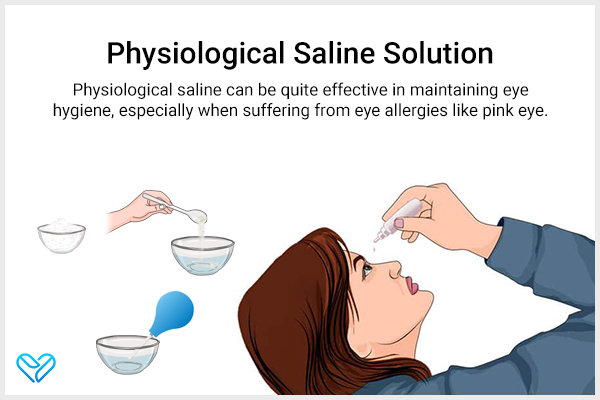
Physiological saline or isotonic saline is a sterilizing agent that is commonly used to clean wounds, nose, and eyes. It can help you maintain proper eye hygiene while suffering from conjunctivitis or other forms of eye allergy or infection.
This solution is composed of 0.9% sodium chloride solution mixed in water and is gentle enough to safely clean the eyes without causing any damage or irritation. (10) It helps remove the goop or discharge collected around the eyes and the allergens from the eyelids.
How to use:
Method 1
- Use a clean dropper to put a few drops of physiological saline solution in the affected eye without making any contact between the two.
- Blink several times to uniformly spread the solution all over the eye surface.
- Repeat the process as necessary.
Method 2
- Soak a clean cloth or cotton ball in the isotopic saline solution.
- Close your eye and gently press the cloth over it. Use another cloth/cotton ball to do the same on the other eye. The pressure will make the solution spill over your eyelid and slowly trickle into your eyes.
- Repeat the procedure as necessary, but use a fresh piece of cloth or cotton ball each time.
Self-Care Measures for Allergic Conjunctivitis
Here are a few additional tips to promote quick recovery from allergic conjunctivitis:
- Do not touch or rub your eyes as it can exacerbate the symptoms of allergic conjunctivitis.
- Do not wear contact lenses or eye makeup as it can worsen your condition.
- Drink plenty of water throughout the day to keep your eyes well-hydrated and to support your general health.
- Avoid triggers such as pollen, ragweed, dust, grass, mold, and animal dander.
Preventive Tips for Allergic Conjunctivitis
The only way to prevent allergic conjunctivitis is to avoid exposure to allergens that trigger it. If you frequently suffer from this condition, you are advised to adopt the following preventive measures:
- During pollen season, spend most of your time indoors and make sure all the windows remain closed to keep it from getting inside.
- Regularly vacuum or clean your home to keep dust and dander from collecting inside.
- If you notice any sign of mold growth inside your home, get it removed as soon as possible.
- Ask your doctor to prescribe you allergy medication that can help reduce the severity and frequency of flare-ups.
Most-Asked Questions About Allergic Conjunctivitis
What are the different types of allergic conjunctivitis and their varied symptoms?
The different types of allergic conjunctivitis are:
1. Seasonal allergic conjunctivitis
Seed plants produce tiny spores called pollen, which are released into the environment during spring, summer, and early fall, collectively known as the pollen season.
Exposure to airborne pollen can trigger allergic conjunctivitis in some people. Since this type of conjunctivitis is caused by seasonal allergens and only occurs during the pollen season, it is referred to as seasonal allergic conjunctivitis.
Another name for this condition is hay fever conjunctivitis.
2. Perennial allergic conjunctivitis
Perennial allergic conjunctivitis is not limited to a specific time of the year unlike its seasonal counterpart. It is triggered by nonseasonal allergens such as mites, dust, pet dander, and mold spores that can be found in indoor settings all year round.
Thus, this condition can flare up any time throughout the year.
Vernal keratoconjunctivitis
Vernal keratoconjunctivitis is a relatively severe form of conjunctivitis that is usually triggered by an allergen. Males between the ages of 5 and 20 years who suffer from eczema, asthma, or seasonal allergies are most prone to this condition.
This condition tends to flare up during spring but subsides in the fall and winter. Kids often outgrow this condition by early adulthood. (3)
What are the treatments for allergic conjunctivitis?
Standard medical treatment for allergic conjunctivitis is as follows:
- Mild cases of allergic conjunctivitis can usually be treated with topical OTC medications, which include antihistamines such as pheniramine and vasoconstrictors such as naphazoline.
- If your condition does not improve with this primary treatment, the doctor may prescribe a stronger topical antihistamine such as olopatadine or ketotifen, NSAIDs such as ketorolac, or mast cell stabilizers such as pemirolast, nedocromil, and azelastine. These drugs may be used separately or in combination.
- If the above interventions don’t work or your symptoms keep coming back, the doctor may prescribe topical corticosteroids or cyclosporine.
Final Word
Allergic conjunctivitis is rarely a cause for concern but it can be quite discomforting while it lasts. The above-listed tips and remedies should suffice to treat it at home, but seek medical help if your symptoms are severe, become worse with time, or last for more than a couple of days.
- Was this article helpful?
- YES, THANKS!NOT REALLY


